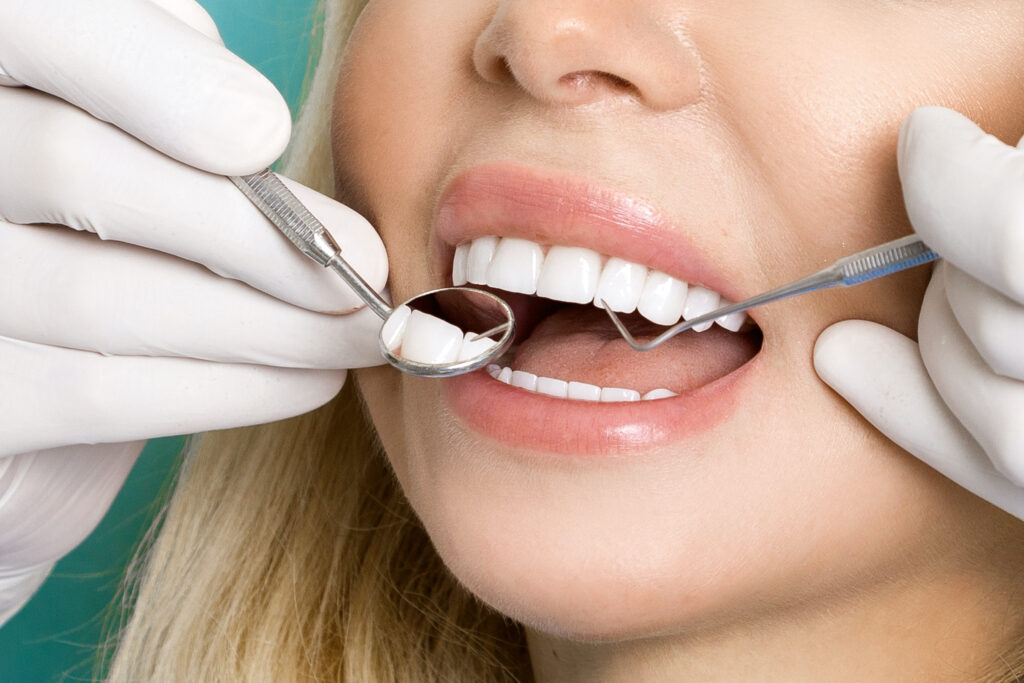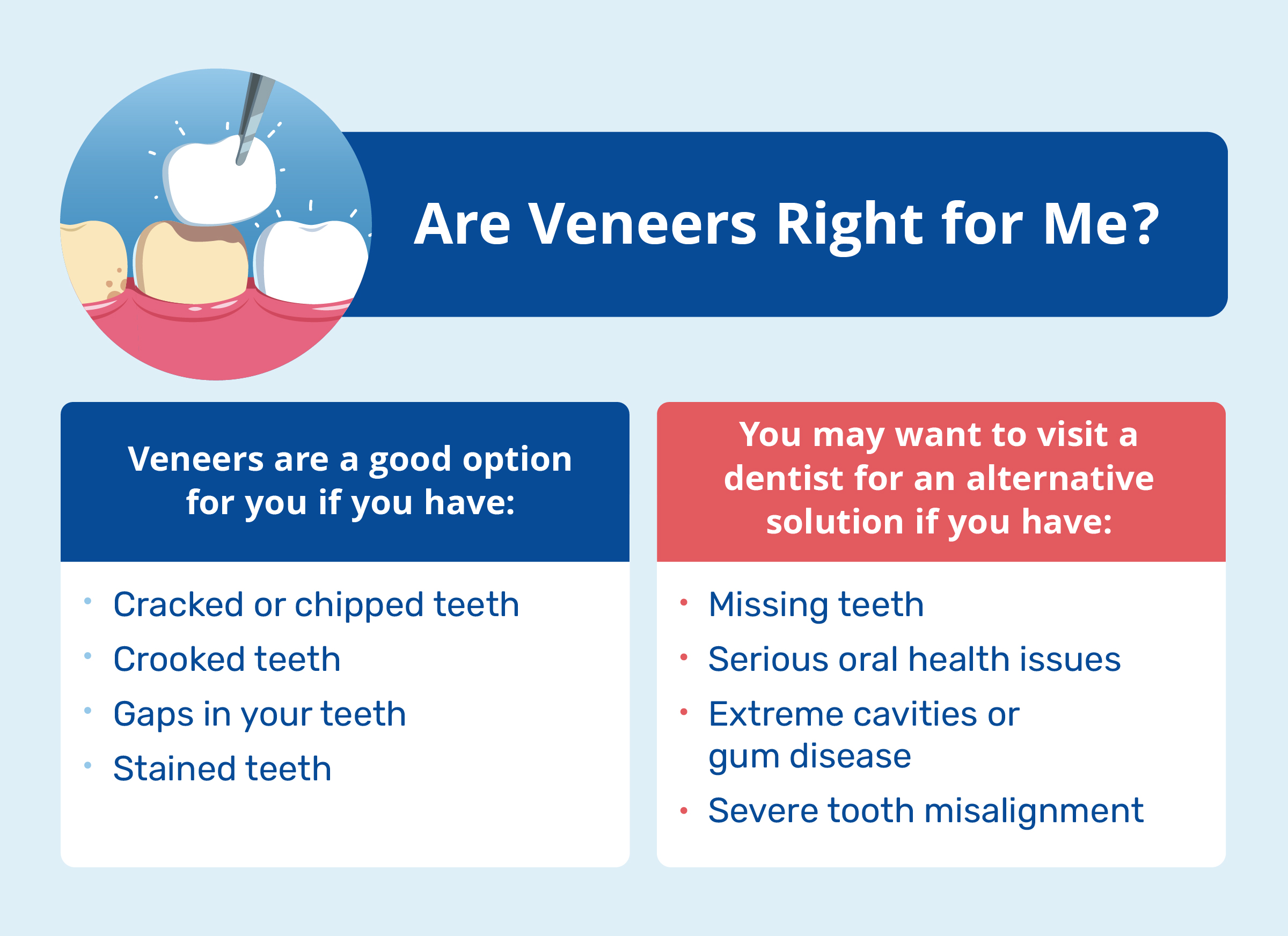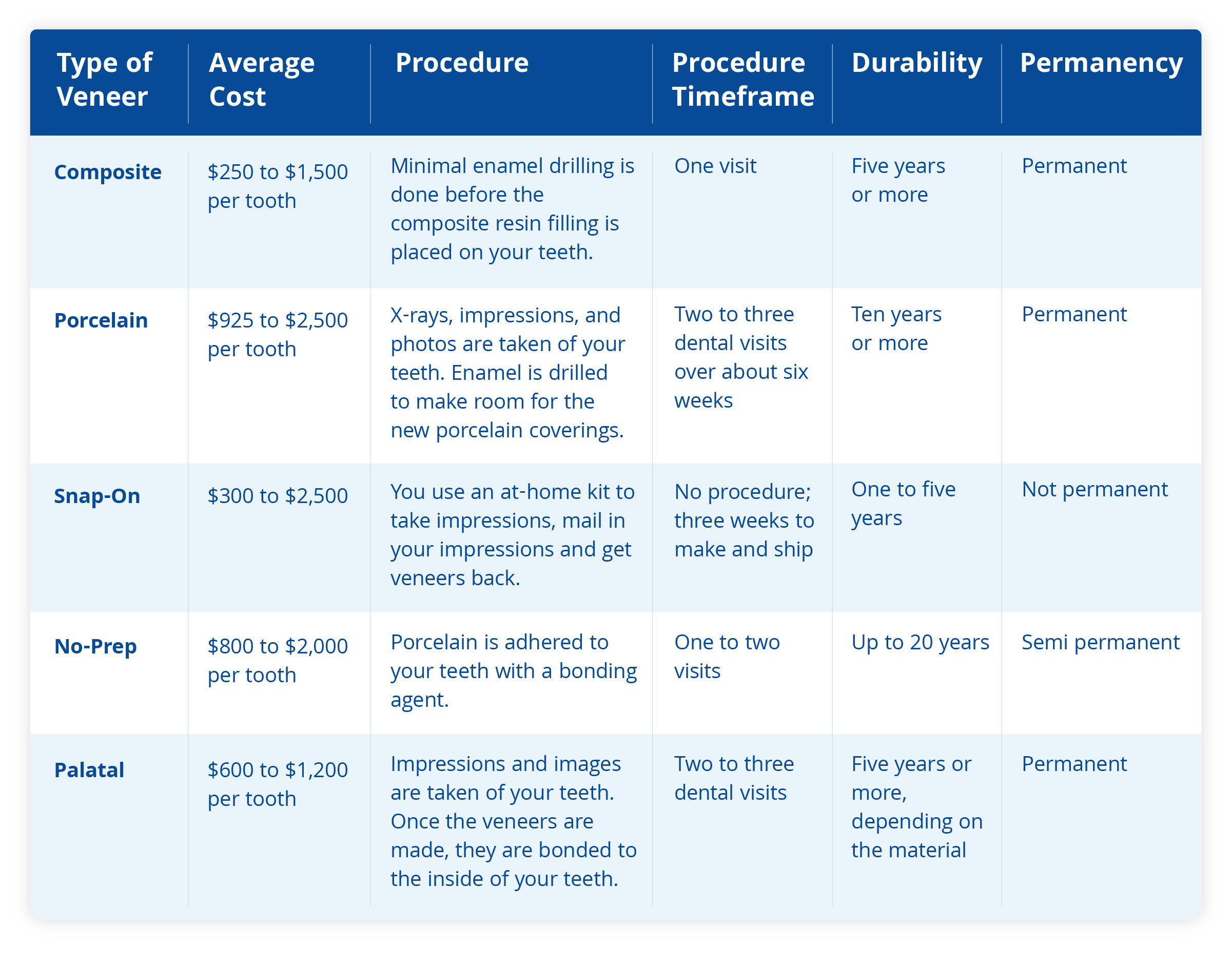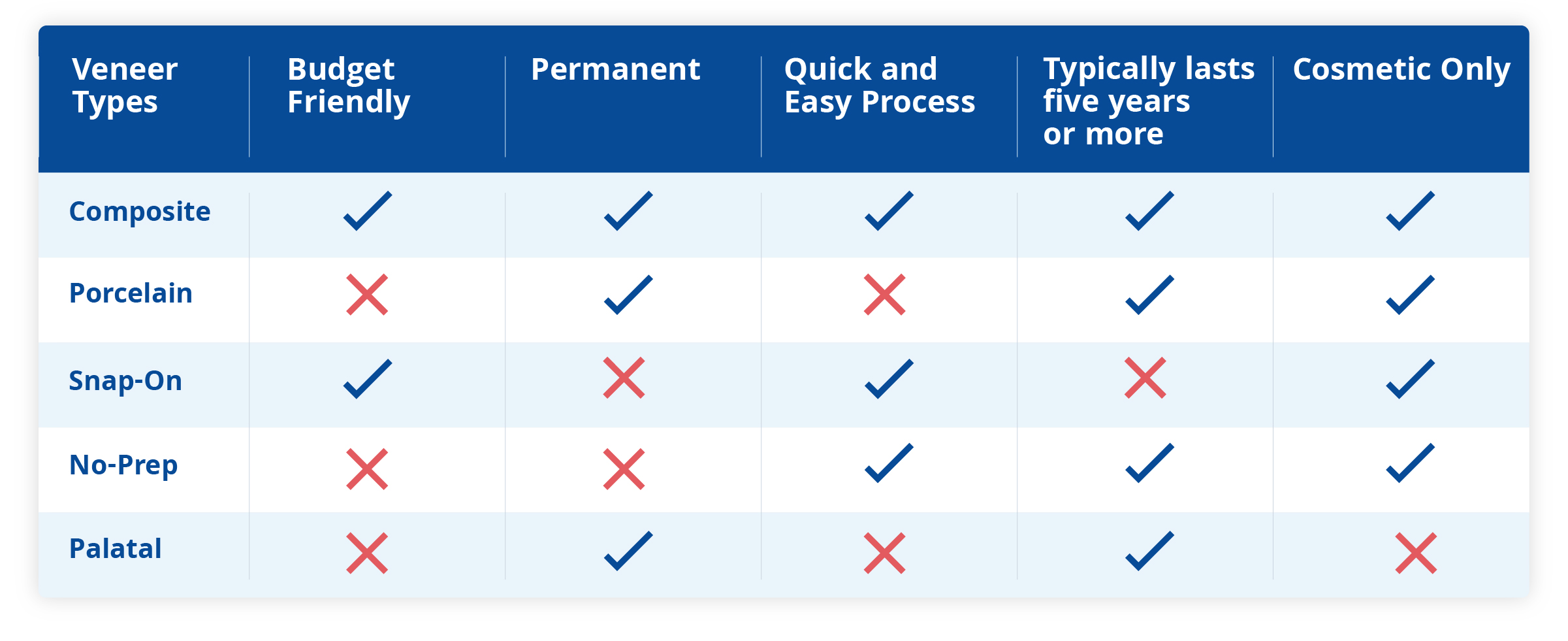

A dental veneer is a layer of material placed over a tooth, typically for cosmetic purposes. There are five main types of veneers: snap-on, no-prep, composite, porcelain, and palatal.
Porcelain and composite are types of permanent veneers, meaning they’re adhered to your teeth after your tooth enamel is drilled down. Permanent veneers still need to be replaced about every ten to fifteen years, but they’re a permanent procedure because the enamel loss can’t be reversed. Palatal veneers are also permanent, but the procedure is different — they’re bonded to the inside of your teeth instead.
Semi-permanent veneers, like no-prep veneers, are bonded to your teeth, but they aren’t permanent because there’s no enamel removal involved — they don’t affect the tooth structure the way permanent veneers do. However, the bonding agent used in this process can still cause damage to your natural teeth if the veneers are removed.
Non-permanent or temporary veneers, like snap-on veneers, aren’t bonded to your teeth at all. They’re removable veneers, worn similarly to a retainer, and are usually designed for shorter-term wear.
If you’re ready to get your beautiful smile back, a set of veneers might be the right option for you. In this post, we go over the five main types of dental veneers to explain how they work, what veneers cost, and what to expect during and after treatment.
Are Veneers Right for You?
Veneers are a great solution to many dental problems, but they aren’t for everyone. If you’re not sure whether veneers are right for you, consult with your dentist for their recommendation.

Typically, veneers help with dental conditions like:
- Cracked or chipped teeth
- Crooked teeth
- Gaps in teeth
- Discoloration or stained teeth
You might want to consider a different dental treatment for things like:
- Missing teeth
- Serious oral health issues
- Extreme cavities or gum disease
- Severe tooth misalignment
Here’s an overview of the different types of veneers, their average cost, procedure details, and how they hold up:

1. Composite Resin
Permanent composite resin veneers are a cheaper alternative to porcelain veneers. However, they’re less durable, so they’ll need to be replaced more often, and the composite materials used to make them are more susceptible to staining. Similar to porcelain veneers, you can have composite veneers fixed if they get damaged.
While the dental procedure is less invasive compared to porcelain veneers, you’ll still have some enamel removed, just not quite as much. The process involves minimal drilling of the enamel. Then, a composite resin filling is placed on top of the teeth that bonds directly to the teeth. The procedure typically takes about one day.
Durability:
- Lasts five years or more
Cost:
- $250 to $1,500 per tooth
Choose composite if:
- You want a cheaper upfront cost than porcelain.
- You want a quick, permanent, veneer process that takes a day.
2. Porcelain
Porcelain veneers are traditional veneers. They’re the most natural-looking option you can get, because this veneer material looks the most like our natural tooth enamel.
They’re more stain-resistant and durable than composite resin or even other kinds of ceramic veneers, giving them the longest lifespan of any veneer.
The procedure involves two or three dentist visits over a six-week period. During these visits, you’ll get x-rays, impressions, and photographs of your teeth. Similar to composite resin, the main veneers procedure involves tooth preparation where your dentist drills down your enamel to make space for your new porcelain tooth coverings.
Porcelain veneers are highly customizable in terms of their color, shape, fit, and size, so they may take some time for a dental lab to create. Your dentist might send you home with temporary veneers to wear until your porcelain ones are ready. Once they’re ready, you’ll be back in the office again to have the porcelain veneers bonded to your teeth.
Durability:
- Lasts 10 years or more
Cost:
- $925 to $2,500 per tooth
Choose porcelain if:
- You want the most natural-looking veneers.
- You want long-lasting, permanent veneers.
3. Snap-On
Snap-on veneers are a type of non-permanent veneer. You put them on like a mouthguard—they “snap on” to your teeth.
With snap-on veneers, you can get a perfect smile in an instant without risking damage to your teeth. You won’t have to get any enamel removed or dental cement applied to your tooth surfaces. You can also remove these veneers as needed.
You can get custom-made clip-on veneers using an at-home impressions kit through Shiny Smile Veneers. Simply make your impressions, send them back in, and receive your fitted veneers in the mail.
Durability:
- Shiny Smile Veneers can last one to five years depending on how you take care of them. You can eat soft foods and drink cold liquids while wearing them.
Cost:
- $370 for Shiny Smile Veneers single arch
- $570 for Shiny Smile Veneers top and bottom set
- $300 to $2,500 on average
Choose snap-on if:
- You want a non-permanent option that doesn’t require a dentist visit.
- You want an inexpensive option.
4. No-Prep (Lumineers)
No-prep veneers, a type of semi-permanent veneer, give you the option of having porcelain tooth coverings without the enamel removal. Though your teeth can still be damaged if you have semi-permanent veneers installed and then taken out, no enamel is removed to place them on your teeth.
Lumineers are the most popular brand of no-prep veneers. Other brands include DURAthin and Vivaneers. These veneers can typically be created and adhered to your teeth in a same-day procedure, making it an easy process.
Durability:
- The manufacturers of Lumineers claim they last up to 20 years, but other sources report that they only last up to 10 years.
Cost:
- Lumineers cost between $800 and $2,000 per tooth.
Choose no-prep if:
- You want a quick and easy process that takes a day.
- You want the next closest thing to permanent veneers without being permanent.
5. Palatal
Palatal veneers, also known as palatal onlays or lingual veneers, are veneers made of either composite or porcelain material that are placed on the inside of your teeth. This type of veneer is sometimes used as a less-invasive alternative to dental crowns.
They’re called palatal veneers because of where they’re placed — on tooth surfaces that face the inside of the mouth, helping to restore your anterior or front teeth from wear and tear. They might be a good option if your teeth are damaged by dental erosion, deep bite, or bruxism.
Placement is a multi-step process that happens over several weeks. First, your dentist takes impressions of your teeth. Once the veneers are made, they’re bonded to the backsides of your teeth. A small amount of enamel may be drilled down in order to make room for the veneers, making the process permanent or irreversible.
Durability:
Cost:
- $600 to $1,200 per tooth
Choose palatal veneers if:
- You need to restore anterior teeth due to erosion or damage.
- You want to address both cosmetic and practical teeth restorations.

Tips for Maintaining Your Veneers
Proper maintenance and good dental hygiene are key to getting the most out of your treatment. Regardless of which type of veneer you choose, these tips can help you keep them in good shape:
- Keep up with oral hygiene. Care for your veneers the way you would care for your teeth. Taking care of your oral health with regular brushing, flossing, and rinsing with alcohol-free mouthwash can help your veneers last for years to come.
- Schedule regular dental care. Just like with your natural teeth, visiting your dentist helps ensure your veneers are in good condition and provides the opportunity to identify any issues before they become a serious problem.
- Brush your teeth regularly, especially after eating or drinking teeth-staining foods. Many types of veneers are vulnerable to certain diets, like high-acid or high-sugar foods, and habits like smoking or drinking. Brushing your teeth can help prevent these things from damaging your veneers.
- Be conscientious of the foods you eat, especially sticky or hard foods. In addition to being more vulnerable to acidic or sugary foods, sticky and hard foods can chip or wear down your veneers. It’s best to either avoid them or be very careful.
Choose Snap-On Veneers to Elevate Your Smile
If you’re ready for a smile makeover, veneers might be the right choice for you. And if you’re unsure about a permanent solution, Shiny Smile Veneers lets you order a high-quality temporary set in just a few easy steps.
Your Shiny Smile Veneers are customized to your preferences, down to the material thickness and color you want. Since they aren’t permanent, they don’t damage your teeth and won’t involve as much maintenance. Plus, you don’t even have to visit your dentist to get them — you can go through the whole process from the comfort of your home, using our at-home impressions kit.
A perfect smile isn’t out of reach. Try Shiny Smile Veneers today and see what they can do for your confidence.
